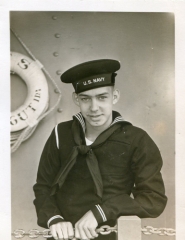Lloyd D. McKee

Lloyd D. McKee
LLOYD
D.
MCKEE
SOLDIER DETAILS
BIOGRAPHY
I joined the U.S. Navy in Kansas City, Missouri, and took Basic Training and Radio School in Farragut, Idaho. I was sent to Boat Basin near San Clemente, California, where I was issued full Marine combat gear and went through amphibius training. When completed, my group was shipped out to Oahu, Hawaii on a converted pineapple cargo ship. I was stationed at a camp near the entrance of Pearl Harbor from May 1944 to August 1944. I had radio duty while awaiting assignment in the Asiatic Theater. While there I met my cousin, Lewis McKee, my Abilene classmate and close friend, as he was awaiting assignment with the Fleet. I was assigned with 8 other radiomen to a Seabee outfit called Gropac 10. We were in the Palau Islands occupied with the Japanese. The U. S. needed Palau for a Navy airbase and Anguar 5 miles south, for an Army B-24 airstrip. Both were seized after heavy fighting and were secured. Gropac 10 landed D-5 after the Fleet had partially secured three beaches and destroyed the major town there. The duty of the Seabees of Gropac 10 was to restore ways to land equipment and supplies to build the airstrip, and provide proper facilities for the American occupation. My unit of radiomen worked on 3 different beaches of the Island and we served as the source of communication between the supply ships, landing craft and the shores of Angaur. The whole series of Islands that make up the Palaus covered over 100 miles in length and the Navy surrounded them with many ships and landing crafts that we kept in contact via voice messages. At the northern end of the Palau Island was a large reef area that was named Kossol Roads. It was used as a staging area for the U.S. Fleet. They could sail this far east without escort. We were 300 miles east of the Philippines and still occupied by the Japanese. While I was there, I was assigned to a decommissioned LST that served as the Port Director for this staging area. It was known at that time as the only non-land Port Director in the world. After that duty, I returned to Anguar and rejoined my unit that was the command communication source for the island. After 10 months of service on Anguar, I was assigned to the Naval Operating Base in Guam to await orders and I received the rank of Radioman 2/c. The war with Japan ended while there and 3 months later I returned to the states on the USS White Plains. I then served a month or so at the US Naval Airbase at Mojave, Ca. and was discharged in San Pedro, California. I took residence in Ontario, California. I used the GI Bill, graduated from Chaffee College with an AA Degree in Electrical Engineering, became a Jr. Wireman in the IBEW Local Union, of which I retired after 49 years of service as a construction electrician.
 Eisenhower Foundation
Eisenhower Foundation
